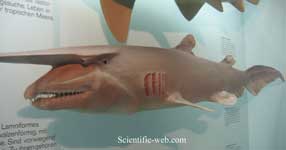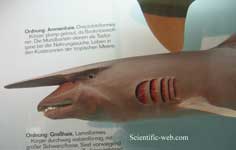

Mitsukurina owstoni , Mitsukurina owstoni ,
The goblin shark, Mitsukurina owstoni, is a deep-sea shark, the sole living species in the family Mitsukurinidae.[2] The most distinctive characteristic of the goblin shark is the unorthodox shape of its head. It has a long, trowel-shaped, beak-like rostrum or snout, much longer than other sharks' snouts. Some other distinguishing characteristics of the shark are the color of its body, which is mostly pink, and its long, protrusible jaws.[2] When the jaws are retracted, the shark resembles a pink grey nurse shark, Carcharias taurus, with an unusually long nose.
Mitsukurina owstoni is found in the deep ocean, far below where the sun's light can reach at depths greater than 200 m. They can be found throughout the world, from Australia in the Pacific Ocean[3] to the Gulf of Mexico in the Atlantic Ocean.[4] They are best known from the waters around Japan, where the species was first discovered by modern science.[5]
Goblin sharks feed on a variety of organisms that live in deep waters. Among some of their known meals are deep-sea squid, crabs and deep-sea fishes. Very little is known about the species' life history and reproductive habits, as encounters with them have been relatively rare. As seemingly rare as they are however, there seems to be no real threat to their populations and so they are not classified as endangered species by the IUCN.[6]
Taxonomy
The goblin shark was originally described in 1898 by Jordan as Mitsukurina owstoni, from a specimen obtained in the Sagami Sea, near Yokohama, Japan.[7]
Another specimen caught was described in 1909 as Scapanorhynchus jordoni by Louis Hussakof. For a time, the species was moved to the genus Scapanorhynchus and was referred to as Scapanorhynchus owstoni, a scientific name now invalid.[8][9]
The fossil record includes another two dozen or so related species in two (extinct) genera, Scapanorhynchus and Anomotodon.
The genus' name Mitsukurina is named after Kakichi Mitsukuri, a Japanese zoologist from the University of Tokyo who was responsible for bringing the then-unidentified specimen to David Jordan for proper taxonomic identification and description.[10][2] The species itself was named by Jordan in honor of avid wildlife collector Allan Owston, who acquired the first specimen from a Japanese fisherman.[11]
The shark's common name is a translation of the Japanese name tenguzame, which was the original term that Japanese fishermen used to refer to the shark prior to its description. It refers to the goblin-like tengu of Japanese folklore, which has a long nose reminiscent of the goblin shark's snout.[10]
Distribution and habitat
Mitsukurina owstoni is a bathydemersal deep-water shark usually found near the sea bottom, at depths of around 250 m. The deepest specimen ever caught was found at 1,300 m.[6][2]
Only about 45 specimens of Mitsukurina owstoni have been described in the scientific literature.[12]
Most goblin sharks that have been caught were from Japan (where it was first discovered), specifically in an area between Tosa Bay and Boso Peninsula. The species' Pacific range is rather large. M. owstoni specimens have been found in the waters off South Africa, from various sites throughout the western Pacific Ocean. Goblin sharks have also been found off the coasts of Australia[3] and New Zealand.[13][14]
In the Atlantic Ocean, they have been found in the western Atlantic off French Guiana, in the eastern Atlantic in the Bay of Biscay and off Madeira and Portugal.[6] On the other side of the Atlantic, goblin sharks have been found in the Gulf of Mexico.[4]
Anatomy and appearance
Goblin sharks can grow to 11 feet (3.3 m) long and weigh 350 lb (159 kg).[15] They have the typical shark's semi-fusiform body. Unlike the common image of sharks, M. owstoni's fins are not pointed and instead are low and rounded, with the anal and pelvic fins significantly larger than the dorsal fins. Their heterocercal tails are similar to the thresher shark's, with the upper lobe significantly longer proportionately than other sharks'. In addition, the goblin shark's tail lacks a ventral lobe.[2][16]
The pink coloration, unique among sharks, is due to blood vessels underneath a semi-transparent skin (which bruises easily), thereby causing the coloring. The fins have a bluish appearance. Goblin sharks lack a nictitating membrane. They have no precaudal pit and no keels. The front teeth are long and smooth-edged, while the rear teeth are adapted for crushing.[17]
Up to 25% of the goblin shark's body weight can be its liver. It is currently not understood why the shark has such a large liver.[5]
Behaviour
Goblin sharks hunt by sensing the presence of prey with electro-sensitive organs in the rostrum, or snout, due to the absence of light in the deep waters where it swims. Once a shark finds its prey, it suddenly protrudes its jaws, while using a tongue-like muscle to suck the victim into its sharp front teeth. Some prey they have been known to feed on include deep-sea rockfish, (Helicolenus dactylopterus was found in one specimen), cephalopods and crustaceans.[18]
Reproduction
Next to nothing is known from the goblin sharks' reproductive habits. Even though a pregnant goblin shark has never been caught or found, as members of the order Lamniformes, they are assumed to be ovoviviparous; their eggs mature and hatch inside the mother's body and the shark "gives birth" to live young.[18]
Importance to humans
Goblin sharks are most often encountered as fisheries' bycatch. As they stay near the sea bottom, they are usually caught via deep bottom-set gillnets and sea-bottom long line fishing. They are also sometimes caught by trawling. In addition, they are sometimes found entangled by deep-sea fishing lines.[6]
There is a demand by some collectors for the skeletal jaws of goblin sharks. Prices of these jaws range from US$1,500 to US$4,000.[6]
Specific occurrences
The first goblin shark discovered was caught by a Japanese fisherman in the Kuroshio Current off the coast of Yokohama, Japan in 1897. This specimen was later identified as a 3.5-ft male shark.[5][10]
In 1985, a goblin shark was discovered in waters off eastern Australia.[3] Several specimens have been caught in the vicinity of New South Wales and Tasmania and are preserved at the Australian Museum.[11] A four-meter long specimen was caught in waters off Tasmania in 2004. The shark was taken to the national fish collection in Hobart.[19] In nearby New Zealand, a goblin shark was also caught in 1988.[13]
In 2003, more than a hundred goblin sharks were caught off the northwest coast of Taiwan, an area in which they have previously not been found. Reportedly, the sharks were caught a short time after an earthquake occurred in the area.[6]
A goblin shark was kept by the Tokai University of Japan; the fish in question died after a week.[18]
On January 25, 2007 a 1.3 m long goblin shark was caught alive in Tokyo Bay, in waters 150 to 200 m (500 to 650 ft) deep. It was taken to the Tokyo Sea Life Park to be displayed in an aquarium, but died two days later on January 27.[20][21]
Later the same year in April, several animals were seen swimming in shallow waters in the Japanese Sea. A live one was caught near Tokyo Bay. It is the first time the animals have been seen swimming in shallow waters. Role in the ecosystem
The goblin shark is an upper-level carnivore in its natural habitat. As a macro-organism, it has its fair share of external and internal parasites. Two new species of tapeworm were discovered in a specimen captured off Australia, Litobothrium amsichensis and Marsupiobothrium gobelinus.[18]
Conservation Status
In 2004, Mitsukurina owstoni was classified by the IUCN's Shark Red List Authority as a species of "Least Concern". The rationale given was that despite the fact that goblin shark sightings have been relatively rare, the worldwide distribution of the species, combined with the fact that it was not accidentally taken often as bycatch in fisheries ensured that the species is most probably not in any reasonable danger of extinction. The IUCN described the major threats to M. owstoni populations' as either harvesting (as an intentional target for fishing), accidental mortality (bycatch) and to a lesser-extent, water pollution. There are no active conservation efforts being made toward this specific species.[6]
References
- ^ Sepkoski, Jack (2002). "A compendium of fossil marine animal genera (Chondrichthyes entry)". Bulletins of American Paleontology 364: p.560. http://strata.ummp.lsa.umich.edu/jack/showgenera.php?taxon=575&rank=class. Retrieved on 9 January 2008.
- ^ a b c d e "Mitsukurina owstoni". FishBase. Ed. Ranier Froese and Daniel Pauly. 10 2005 version. N.p.: FishBase, 2005.
- ^ a b c Stevens, J. D.; J. R. Paxton (1985). "A new record of the goblin shark, Mitsukurina owstoni (Family Mitsukurinidae), from eastern Australia". Proceedings of the Linnean Society of New South Wales (The Linnean Society of New South Wales) 108 (1): 37–45.
- ^ a b Parsons, G. R.; G. W. Ingram Jr. and R. Havard (2002). "First record of the goblin shark Mitsukurina owstoni, Jordan (Family Mitsukurnidae) in the Gulf of Mexico". Southeastern Naturalist (Humboldt Field Research Institute) 1 (2): 189–192. doi:10.1656/1528-7092(2002)001[0189:FROTGS]2.0.CO;2.
- ^ a b c Johnson, Dana. "Goblin Shark - Mitsukurina owstoni". Green Goblin Unlimited. http://www.greengoblin.com/internal/corner/shark.html. Retrieved on 2007-02-08.
- ^ a b c d e f g Duffy, C.A.J., Ebert, D.A. & Stenberg, C. (2004). Mitsukurina owstoni. 2006 IUCN Red List of Threatened Species. IUCN 2006. Retrieved on 11 May 2006.
- ^ Jordan, David S. (1898). "Description of a species of fish (*Mitsukurina owstoni*) from Japan, the type of a distinct family of lamnoid sharks". Proceedings of the California Academy of Science (Series 3) (The California Academy of Science) 1 (6): 199–204.
- ^ Mitsukurina owstoni (TSN 159895). Integrated Taxonomic Information System. Retrieved on 9 February 2007.
- ^ Scapanorhynchus owstoni (TSN 159894). Integrated Taxonomic Information System. Retrieved on 9 February 2007.
- ^ a b c Reader, Sally. "Goblin Shark". Australian Museum Collections - Ichthyology -. Australian Museum. http://www.amonline.net.au/collections/ichthyology/shark.htm. Retrieved on 2007-02-09.
- ^ a b McGrouther, M. (2006). "Goblin Shark - Mitsukurina owstoni (Jordan, 1898)". Find a Fish. Australian Museum Online. http://www.amonline.net.au/fishes/fishfacts/fish/mowstoni.htm. Retrieved on 2007-02-08.
- ^ Martin, Richard Aidan. "Goblin Shark (Mitsukurina owstoni) Specimens in the Scientific Literature". Biology of Sharks and Rays. ReefQuest Center for Shark Research. http://www.elasmo-research.org/education/shark_profiles/mitsu_specimens.htm. Retrieved on 2007-02-09.
- ^ a b Stewart, A. L.; M. R. Clark (1988). "Records of three families and four species of fish new to the New Zealand fauna". New Zealand Journal of Zoology (The Royal Society of New Zealand) 15: 577–583.
- ^ Duffy, C. A. J.; M. R. Clark (1997). "Further records of the goblin shark, Mitsukurina owstoni (Lamniformes: Mitsukurinidae), from New Zealand". New Zealand Journal of Zoology (The Royal Society of New Zealand) 24: 167–171.
- ^ Kindersley, Dorling (2001,2005). Animal. New York City: DK Publishing. ISBN 0-7894-7764-5.
- ^ Martin, Richard Aidan. "Family Mitsukurinidae: Goblin Shark - 1 species". Biology of Sharks and Rays. ReefQuest Center for Shark Research. http://www.elasmo-research.org/education/shark_profiles/mitsukurinidae.htm. Retrieved on 2007-02-09.
- ^ Martin, Richard Aidan (1999). "Biology of the Goblin Shark (Mitsukurina owstoni)". Sharks. GreenGoblin.com. http://www.greengoblin.com/internal/corner/rickmartin.html. Retrieved on 2007-02-09.
- ^ a b c d Jordan, Vanessa. "Biological Profiles: Goblin Shark". Ichthyology at the Florida Museum of Natural History. Florida Museum of Natural History. http://flmnh.ufl.edu/fish/Gallery/Descript/GoblinShark/GoblinShark.html. Retrieved on 2007-02-10.
- ^ "Researchers to study rare shark" (in english), ABC News Online, Australian Broadcasting Corporation (2004-02-02). Retrieved on 9 February 2007.
- ^ "Rarely seen 'living fossil' shark caught off Tokyo". Yahoo! News. Yahoo! Inc.. 2007-02-07. http://news.yahoo.com/s/afp/20070207/sc_afp/japanwildlifeshark. Retrieved on 2007-02-08.
- ^ "Goblin shark caught alive". Zoo Net. Tokyo Zoological Park Society. 2007-01-25. http://www.tokyo-zoo.net/topic/topics_detail?kind=news&link_num=6190. Retrieved on 2007-02-17.
External links
Retrieved from "http://en.wikipedia.org/"
All text is available under the terms of the GNU Free Documentation License

